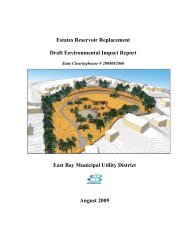You also want an ePaper? Increase the reach of your titles
YUMPU automatically turns print PDFs into web optimized ePapers that Google loves.
noise at any instant in time, community noise levels vary continuously. Most environmental noiseincludes a conglomeration of noise from distant sources, which create a relatively steady backgroundnoise in which no particular source is identifiable. To describe the time-varying character ofenvironmental noise, the statistical noise descriptors, L 01 , L 10 , L 50 , <strong>and</strong> L 90 , are commonly used.They are the A-weighted noise levels equaled or exceeded during 1%, 10%, 50%, <strong>and</strong> 90% of astated time period. A single number descriptor called the L eq is also widely used. The L eq is theaverage A-weighted noise level during a stated period of time.In determining the daily level of environmental noise, it is important to account for the difference inresponse of people to daytime <strong>and</strong> nighttime noises. During the nighttime, exterior backgroundnoises are generally lower than the daytime levels. However, most household noise also decreases atnight <strong>and</strong> exterior noise becomes very noticeable. Further, most people sleep at night <strong>and</strong> are verysensitive to noise intrusion. To account for human sensitivity to nighttime noise levels, a descriptor,L dn (day/night average sound level), was developed. The L dn divides the 24-hour day into thedaytime of 7:00 AM to 10:00 PM <strong>and</strong> the nighttime of 10:00 PM to 7:00 AM. The nighttime noiselevel is weighted 10 dB higher than the daytime noise level. The Community <strong>Noise</strong> EquivalentLevel (CNEL) is another 24-hour average, which includes both an evening <strong>and</strong> nighttime weighting.Fundamentals of Groundborne <strong>Vibration</strong>Ground vibration consists of rapidly fluctuating motions or waves with an average motion of zero.Several different methods are typically used to quantify vibration amplitude. One is the Peak ParticleVelocity (PPV) <strong>and</strong> another is the Root Mean Square (RMS) velocity. The PPV is defined as themaximum instantaneous positive or negative peak of the vibration wave. The RMS velocity isdefined as the average of the squared amplitude of the signal. The PPV <strong>and</strong> RMS vibration velocityamplitudes are used to evaluate human response to vibration. In this section, a PPV descriptor withunits of mm/sec. or in/sec. is used to evaluate construction generated vibration for building damage<strong>and</strong> human complaints. Table 3 displays the reactions of people <strong>and</strong> the effects on buildings thatcontinuous vibration levels produce. The annoyance levels shown in Table 3 should be interpretedwith care since vibration may be found to be annoying at much lower levels than those shown,depending on the level of activity or the sensitivity of the individual. To sensitive individuals,vibrations approaching the threshold of perception can be annoying.Low-level vibrations frequently cause irritating secondary vibration, such as a slight rattling ofwindows, doors or stacked dishes. The rattling sound can give rise to exaggerated vibrationcomplaints, even though there is very little risk of actual structural damage. In high noiseenvironments, which are more prevalent where groundborne vibration approaches perceptible levels,this rattling phenomenon may also be produced by loud airborne environmental noise causinginduced vibration in exterior doors <strong>and</strong> windows.Construction activities can cause vibration that varies in intensity depending on several factors. Theuse of pile driving <strong>and</strong> vibratory compaction equipment typically generates the highest constructionrelated ground-borne vibration levels. Because of the impulsive nature of such activities, the use ofthe peak particle velocity descriptor (PPV) has been routinely used to measure <strong>and</strong> assess groundbornevibration <strong>and</strong> almost exclusively to assess the potential of vibration to induce structuraldamage <strong>and</strong> the degree of annoyance for humans.2

















